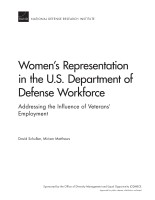| 来源类型 | Research Reports
|
| 规范类型 | 报告
|
| DOI | https://doi.org/10.7249/RR2458
|
| 来源ID | RR-2458-OSD
|
| Women's Representation in the U.S. Department of Defense Workforce: Addressing the Influence of Veterans' Employment |
| David Schulker; Miriam Matthews
|
| 发表日期 | 2018
|
| 出版年 | 2018
|
| 页码 | 52
|
| 语种 | 英语
|
| 结论 |
High proportions of veterans mean less women's representation- The proportion of employees who are veterans is the primary contributor to the explained portion of the gaps in women's representation between the DoD civilian workforce, the non-DoD civilian federal workforce, and the CLF.
- The high proportion of DoD employees who are veterans contributes to the gap in women's representation between the CLF and both DoD and the non-DoD workforce; the latter gap is smaller than the former, though, because the proportion of non-DoD employees who are veterans is less than half that in the DoD workforce.
Substantially increasing long-run representation of women in the workforce would require significant changes in hiring- New hires who are veterans are much more likely than nonveteran new hires to be men.
- However, female employees had lower continuation rates than male employees had, which could also tend to reduce women's representation under a given level of hiring in the long run.
- Hiring nonveteran women is insufficient to replace retention losses.
- Substantial changes in hiring veterans are necessary before projections show either prevention of a long-run decline or numbers in line with those for the relevant CLF.
- If the proportion of new hires who are veterans stays the same but women's representation among nonveteran new hires increases, a majority of nonveteran new hires need to be women before projections maintain the initial level of women's representation over time.
|
| 摘要 |
- The changes in the composition of the DoD workforce that would be required to reach the relevant CLF benchmark could also have secondary impacts that planners should investigate, such as whether veterans possess certain skills or experiences that are uncommon among nonveterans and difficult or costly to develop internally.
- An alternative to focusing on a single factor might be to take an incremental approach across the areas of recruiting, onboarding, and retention. In this vein, the best path forward for DoD planners seeking to increase women's representation would be to identify feasible policy changes in each area that address representation gaps, and then assess the projected representation levels under each policy change using workforce projection techniques. Policymakers would then be able to weigh the costs of these changes against the potential benefits in terms of gender diversity.
|
| 主题 | Gender Equity in the Workplace
; United States Department of Defense
; Veterans Employment
|
| URL | https://www.rand.org/pubs/research_reports/RR2458.html
|
| 来源智库 | RAND Corporation (United States)
|
| 引用统计 |
|
| 资源类型 | 智库出版物
|
| 条目标识符 | http://119.78.100.153/handle/2XGU8XDN/108896
|
推荐引用方式
GB/T 7714 |
David Schulker,Miriam Matthews. Women's Representation in the U.S. Department of Defense Workforce: Addressing the Influence of Veterans' Employment. 2018.
|
|
文件名:
|
x1541599817262.jpg
|
|
格式:
|
JPEG
|

|
文件名:
|
RAND_RR2458.pdf
|
|
格式:
|
Adobe PDF
|
除非特别说明,本系统中所有内容都受版权保护,并保留所有权利。